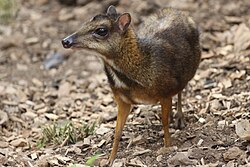The Java mouse-deer (Tragulus javanicus),[2] is a species of even-toed ungulate in the Tragulidae family. At maturity it is about the size of a rabbit, making it one of the smallest ungulates. It is found in forests in Java and perhaps Bali.[1] It formerly included the more widespread T. kanchil and the poorly known T. williamsoni as a subspecies.[3]
| Java Mouse-deer | |
|---|---|

| |
| Java mouse-deer at the Jerusalem Zoo | |
| Scientific classification | |
| Kingdom: | |
| Phylum: | |
| Class: | |
| Order: | |
| Family: | |
| Genus: | |
| Species: | T. javanicus
|
| Binomial name | |
| Tragulus javanicus (Osbeck, 1765)
| |
Taxonomy
The Java mouse-deer’s common scientific name is Tragulus javanicus, although other classification names for it exist, including Tragulus javanica, Cervus javanicus, and Tragulus fuscatus [4]. The Java mouse-deer is also known by many common names, including Javan chevrotain, Javan mousdeer, or Java Mousedeer [5]. The taxonomic status of the Java mouse-deer is questionable, but recent craniometric analyses have begun to shed light on the taxonomic discrepancies. Previously, the Java mouse-deer, Tragulus javanicus, was commonly thought to represent the wider class of large chevrotains, but it was found that these, unlike the Java mouse-deer, do not likely reside on Java. Three species groups of Tragulus have been identified based on craniometric skull analyses and coat coloration patterns. These three species groups are Tragulus javanicus, Tragulus napu, and Tragulus versicolor. Based upon these craniometric analyses, Tragulus javanicus is further separated based on the organisms’ known geographic locations: Tragulus williamsoni (found in northern Thailand and possibly southern China), Tragulus kanchil (found in Borneo, Sumatra, the Thai–Malay Peninsula, islands within the Greater Sunda region, and continental Southeast Asia), and Tragulus javanicus (found in Java) [6]. Thus, because of its uniqueness to the island of Java, the Java mouse-deer is now considered a distinct species, although this fact has not significantly affected its current classification [7].
Appearance and Biology
Mouse-deer posses a triangular-shaped head, arched back, and round body with elevated rear quarters. The thin, short legs which support the mouse-deer are about the diameter of a pencil. Although Java mouse-deer do not posses antlers or horns like regular deer, male Java mouse-deer have elongated, tusk-like upper canines which protrude downward from the upper jaw along the sides of their mouth. Males use these “tusks” to defend themselves and their mates against rivals [8]. Females can be distinguished from males because they lack these prominent canines, and they are slightly smaller than the males [5]. The average size of a Java mouse-deer ranges from 1-2 kg, with females falling on the smaller end of this spectrum. Java mouse-deer can furthermore be distinguished by their lack of upper incisors. The coat coloration of the Java mouse-deer is reddish-brown with a white underside. Pale white spots or vertical markings are also present on the animal’s neck[5].
The height of the Java mouse-deer is 30 centimeters (12 inches) on average. With average lengths of 45 centimeters (18 inches) and an average tail length of 5 centimeters (2 inches), the Java mouse-deer is the smallest extant artiodactyl (even-toe hoofed mammal) [5]. Java mouse-deer are endothermic and homoeothermic, with an average basal metabolic rate of 4.883 W [5]. Tragulus javanicus also possess the smallest erythrocytes of the mammalian species, and their erythrocytes are unique in that 12.8% of their erythrocytes have pits in them[9]. Pitted erythrocytes are unique and have never been seen before physiologically or pathologically. Java mouse-deer are also considered the most primitive ruminants, thus they provide the living link between non-ruminants and ruminant species[10].
Ecology
Geographic Range
Habitat
Behavior
Diet
Social Behaviors
Reproduction & Young
Predators
Diseases
Conservation Status
Importance in Indonesian folklore
References
- ^ a b Template:IUCN2008 Database entry includes a brief justification of why this species is of data deficient.
- ^ "Tragulus javanicus". Mammal Species of the World. Retrieved 2010-03-11.
- ^ Meijaard, I. and Groves, C. P. (2004). A taxonomic revision of the Tragulus mouse-deer. Zoological Journal of the Linnean Society 140: 63-102.
- ^ Javan mouse-deer (Tragulus javanicus). (2013). ARKive - Discover the world's most endangered species. Retrieved from http://www.arkive.org/javan-mouse-deer/tragulus-javanicus
- ^ a b c d e Facts about Lesser Mouse Deer (Tragulus javanicus) - Encyclopedia of Life. (n.d.). Encyclopedia of Life - Animals - Plants - Pictures & Information. Retrieved from http://eol.org/pages/328339/
- ^ Meijaard, E., & Groves, C. P. (2004). A Taxonomic Revision Of The Tragulus Mouse-deer (Artiodactyla). Zoological Journal of the Linnean Society, 140(1), 63-102. Retrieved from http://onlinelibrary.wiley.com/doi/10.1111/j.1096-3642.2004.00091.x/abstract
- ^ Java Mouse Deer, Tragulus javanicus - Mammals Reference Library - redOrbit. (n.d.). redOrbit - Science, Space, Technology, Health News and Information. Retrieved from http://www.redorbit.com/education/reference_library/science_1/mammalia/1112721404/java-mouse-deer-tragulus-javanicus/
- ^ The Lesser Mouse Deer - A Tiny Superhero - pictures and facts. (n.d.). Animal pictures | Facts about mammals. Retrieved from http://thewebsiteofeverything.com/animals/mammals/Artiodactyla/Tragulidae/Tragulus/Tragulus-javanicus.html
- ^ Fukuta, K., Kudo, H., & Jalaludin, S. (1996). Unique pits on the erythrocytes of the lesser mouse-deer, Tragulus javanicus. Journal of Anatomy, 189(1), 211-213. Retrieved from http://www.ncbi.nlm.nih.gov/pmc/articles/PMC1167845/
- ^ Carwardine, M., & London, E. (2007). Animal records. New York: Sterling
